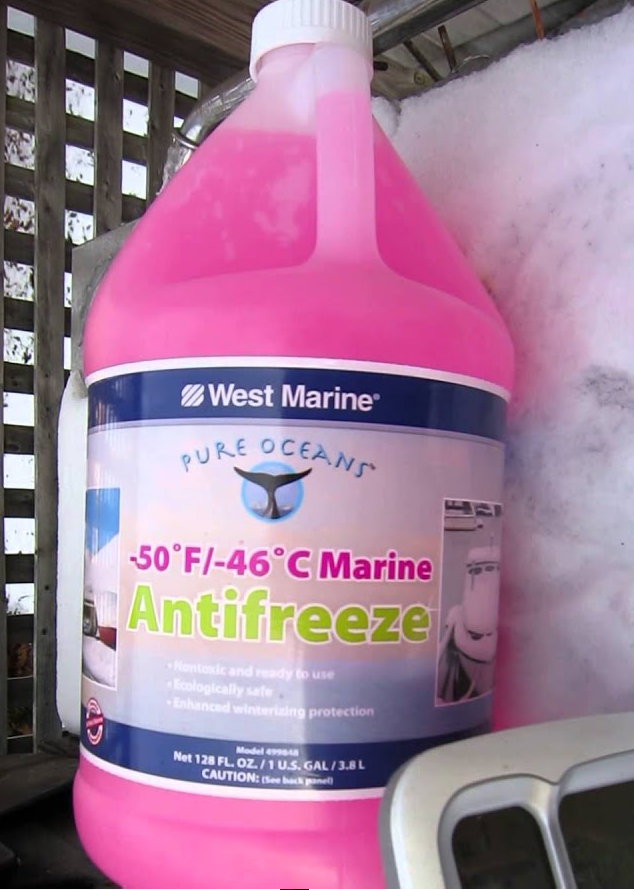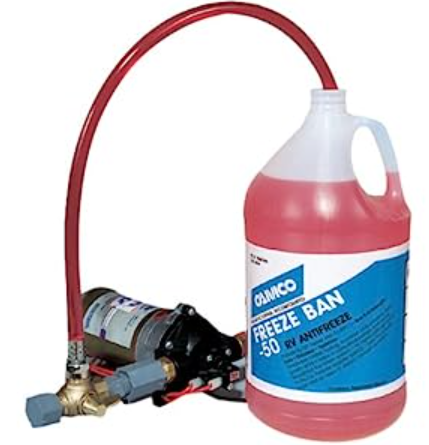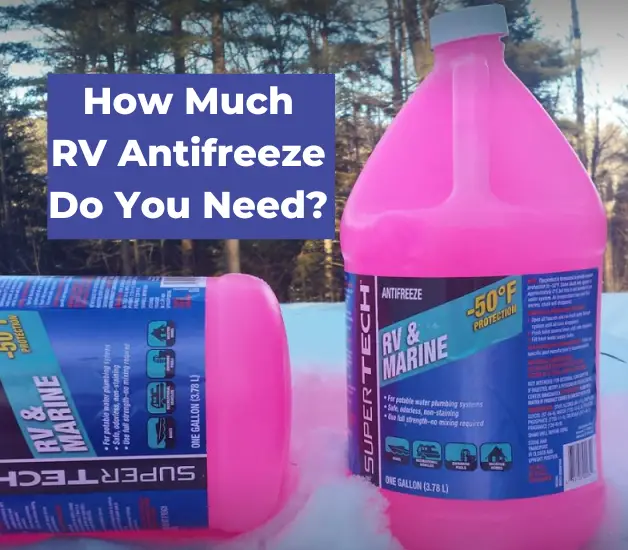RV antifreeze is an essential component in protecting your RV’s plumbing system from freezing during winter months. Many RV owners are unsure of how much antifreeze they need to purchase to properly winterize their vehicles. So how much RV antifreeze do you need? The recommended amount of RV antifreeze for most RVs is roughly 2-4 gallons depending on the size of the RV and the specific winterization process used.
To determine how much RV antifreeze is needed, it is important to follow the recommended winterization steps for your particular RV. Typically, the process involves draining all water from the system, including the water heater, and then pumping RV antifreeze through the system to protect against freezing.
We’ll go over everything you need to know about how much RV antifreeze to use in this guide.
What is RV Antifreeze?

RV antifreeze is a special type of antifreeze used in recreational vehicles (RVs) to protect the plumbing system from freezing during cold temperatures. It is different from regular automotive antifreeze, which is not safe for human consumption.
RV antifreeze is typically pink or red in color, making it easy to distinguish from other types of antifreeze. It is a non-toxic solution that is safe for humans and pets, making it an ideal choice for RVs.
The composition of RV antifreeze can vary, but the most common types are made from either ethanol or propylene glycol. Ethanol-based antifreeze is less expensive but has a lower freezing point than propylene glycol-based antifreeze. Propylene glycol-based antifreeze, on the other hand, is more expensive but has a lower toxicity level and is safer for the environment.
RV antifreeze is designed to lower the freezing point of water, which prevents the water in the RV’s plumbing system from freezing and causing damage. The freezing point of RV antifreeze can vary depending on the type, but it typically ranges from -50°F to -100°F.
Why Do You Need RV Antifreeze?
When winterizing an RV, one of the essential steps is to use RV antifreeze to protect the plumbing system from freezing temperatures. Without proper winterization, the water lines, holding tanks, and plumbing system can freeze, causing damage to the RV’s pipes, valves, and fittings.
RV antifreeze is a non-toxic solution that is specifically designed to protect the plumbing system from freezing. It is different from automotive antifreeze, which is toxic and not suitable for RV use. RV antifreeze is available in either pink or green color, and it is easy to spot in the plumbing system.
Using RV antifreeze is crucial because it prevents the water in the plumbing system from freezing and expanding, which can cause the pipes to burst. Burst pipes can lead to costly repairs and extensive damage to the RV’s plumbing system.
When using RV antifreeze, it is important to ensure that all water lines, holding tanks, and the water heater tank are properly filled with the solution. The RV’s water pump should also be used to circulate the antifreeze throughout the plumbing system, ensuring that all areas are protected.
It is important to note that using RV-specific antifreeze is crucial for proper RV winterization. Automotive antifreeze is not recommended for use in RVs because it can dry out the rubber seals of the toilets or faucets and create leakage. Additionally, it can cause rust and damage to the RV’s plumbing lines, water heater, and other components.
How Much RV Antifreeze Do I Need?

When it comes to winterizing your RV, one of the most important steps is adding RV antifreeze to your plumbing system. But how much do you actually need? The answer can vary depending on the size of your RV and the complexity of your plumbing system.
Most RV owners will need between 2-4 gallons of RV antifreeze to properly winterize their RV. It’s always a good idea to consult your RV owner’s manual for specific recommendations.
RV antifreeze is available in both toxic and non-toxic formulas. While toxic formulas are still available, many RV owners prefer to use non-toxic formulas that are propylene glycol based. These formulas are safer for humans and animals, and are often required by law in certain states.
There are two main methods for adding RV antifreeze to your plumbing system: compressed air and hand pump. Compressed air is the most efficient method, as it allows you to blow out any remaining water in your plumbing system before adding antifreeze. To use this method, you’ll need a blow-out plug and an air compressor.
If you don’t have access to an air compressor, a hand pump can also be used to add antifreeze to your plumbing system. This method involves connecting the hand pump to your city water inlet and pumping antifreeze through your plumbing system.
Adding RV antifreeze to your plumbing system will not protect against mice or other rodents. To prevent these pests from entering your RV, it’s recommended to use other preventative measures such as sealing any openings and using mouse traps.
How to Use RV Antifreeze?
When it comes to winterizing an RV, using antifreeze is an essential step to prevent the water system from freezing and causing damage. But how much RV antifreeze do you need, and how do you use it? Here’s a breakdown of the process:
- Choose the Right Antifreeze: RV antifreeze comes in two types, toxic and non-toxic. It is essential to choose the non-toxic antifreeze as it is safe for the environment, humans, and pets. The most common type of non-toxic antifreeze is propylene glycol-based, which is pink in color.
- Prepare the Water System: Before adding antifreeze, drain and clean the water system thoroughly. This includes draining the water tanks, water heater, and holding tanks. Open all faucets, including the shower, toilet, and any outdoor shower, and let the water drain out completely. Also, remove any water filters and bypass the water pump.
- Add the Antifreeze: Once the water system is drained, it’s time to add the antifreeze. The amount of antifreeze you need depends on the size of your RV and the water system. A general rule of thumb is to use one to two gallons of antifreeze for a small RV and up to five gallons for a larger RV.
- Start with the Water Pump: To add the antifreeze, start with the water pump. Turn on the pump, and open each faucet one at a time, starting with the one closest to the pump. Let the antifreeze run through the faucet until you see the pink color. Repeat this process for each faucet, including the shower, toilet, and any outdoor shower.
- Empty the P-Traps: Once you’ve run antifreeze through all the faucets, empty the p-traps by pouring a small amount of antifreeze down each drain. This will ensure that the antifreeze reaches the entire water system, including the black tank.
- Store the RV: After adding antifreeze to the water system, the RV is ready to be stored for the winter. Make sure to turn off the water pump and close all faucets. It’s also a good idea to label each faucet with a note that says “winterized” to avoid any confusion when de-winterizing.
Here’s a great video walkthrough on how to use RV antifreeze:
Where to Buy RV Antifreeze?
When it comes to buying RV antifreeze, there are several options available to choose from. Here are a few places where one can buy RV antifreeze:
Walmart
Walmart is a popular retail store that sells RV antifreeze. They carry a variety of brands and types of RV antifreeze, including non-toxic and eco-friendly options. One can find RV antifreeze at Walmart both in-store and online.
Amazon
Amazon is an online marketplace that offers a wide range of RV antifreeze options. One can find different brands and types of RV antifreeze on Amazon, including RV-specific antifreeze. Amazon also offers the convenience of home delivery, making it a popular option for those who prefer online shopping.
Camping World
Camping World is a specialty retailer that offers RV-specific antifreeze. They have a wide range of options available, including eco-friendly and non-toxic antifreeze. Camping World also carries special equipment that can be used to winterize an RV.
When buying RV antifreeze, it is important to check the specifications and recommendations of the manufacturer of the RV. This will ensure that one is buying the right type and amount of antifreeze required for the RV.
In conclusion, there are several options available when it comes to buying RV antifreeze. Walmart, Amazon, and Camping World are some of the popular places where one can buy RV antifreeze. It is important to choose the right type and amount of antifreeze required for the RV, based on the manufacturer’s recommendations.
RV Antifreeze Safety Precautions
When handling RV antifreeze, it is important to take certain safety precautions to protect yourself, others, and the environment. Here are some key safety tips to keep in mind:
- Choose the right type of antifreeze: Make sure you are using RV antifreeze, which is specifically designed for use in RV plumbing systems. Do not use automotive antifreeze, which contains ethylene glycol and is highly toxic to humans and animals.
- Check for toxicity: While RV antifreeze is generally considered non-toxic, it is still important to read the label and check for any warnings or precautions. Some brands may contain chemicals that can be harmful if ingested or inhaled.
- Store antifreeze safely: Keep RV antifreeze out of reach of children and pets, and store it in a cool, dry place away from heat sources and open flames. Do not store it in food or beverage containers.
- Dispose of antifreeze properly: Do not pour RV antifreeze down the drain or onto the ground. Instead, follow local regulations for hazardous waste disposal or take it to a designated collection site.
- Check expiration dates: RV antifreeze can lose its effectiveness over time, so make sure to check the expiration date before using it. Expired antifreeze may not provide adequate protection against freezing.
- Protect animals: While RV antifreeze is generally considered safe for pets and wildlife, it is still important to take precautions to prevent accidental ingestion. Keep containers tightly sealed and clean up any spills immediately.
By following these safety precautions, you can help ensure that your RV antifreeze is used safely and responsibly.
Frequently Asked Questions
The amount of RV antifreeze you need for winter depends on the size of your RV. As a general rule of thumb, most RVs will use around 2-4 gallons of antifreeze. The exact amount you need may vary depending on the length of your RV and other factors. For example, you may need more antifreeze if you plan to use your RV in extremely cold temperatures.
To put RV antifreeze in your toilet, you should pour about a cup of antifreeze directly into the bowl. This will help prevent any water left in the bowl from freezing and causing damage to your toilet.
If you’re using RV antifreeze concentrate, you’ll need to dilute it with water before using it. The exact amount of water you need to add will depend on the concentration of the antifreeze. As a general rule of thumb, you should mix one part antifreeze concentrate with two parts water.
Using RV antifreeze is a straightforward process. First, you’ll need to drain all the water from your RV’s plumbing system. Next, you’ll need to pour antifreeze into your RV’s water lines and faucets. Finally, you’ll need to run your RV’s water pump to circulate the antifreeze throughout the system.
To pump antifreeze into your RV’s water pipes, you’ll need to use a special antifreeze pump. These pumps are designed to connect to your RV’s water lines and pump antifreeze throughout the system. To use the pump, simply connect it to your RV’s water lines and follow the manufacturer’s instructions.
Putting antifreeze in your RV’s fresh water tank is not recommended. Instead, you should bypass your RV’s water heater and use antifreeze to fill the water lines and faucets. This will help prevent any damage to your RV’s plumbing system during the winter months.

